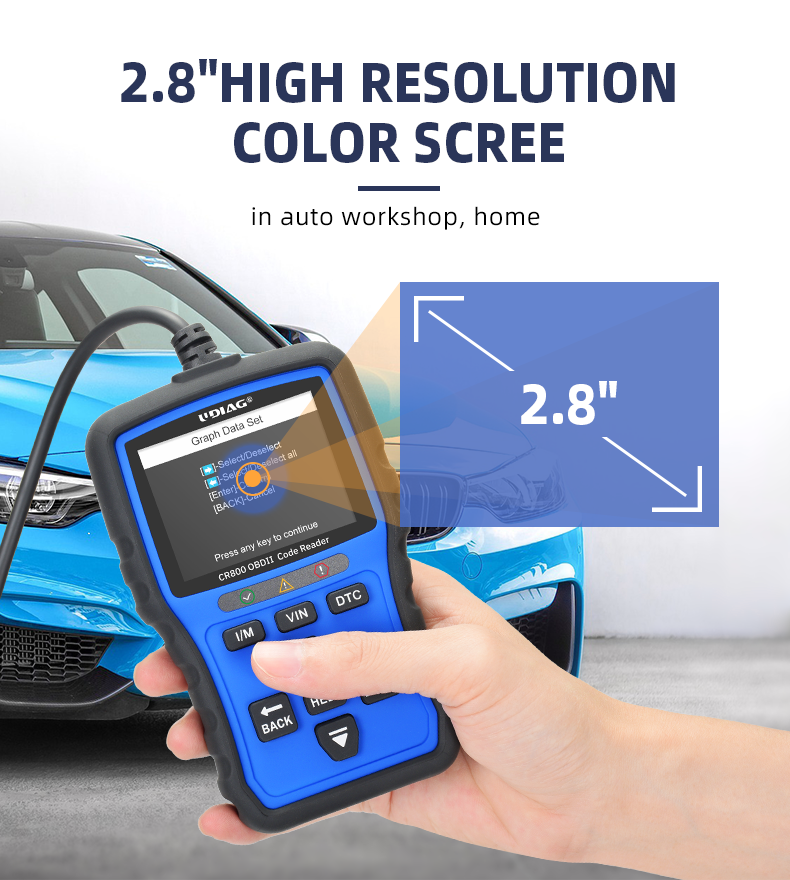How OBDII Code Readers Simplify Vehicle Maintenance.
2024-01-11 by UDIAG
In the dynamic landscape of automotive technology, On-Board Diagnostics II (OBDII) has emerged as a crucial component, playing a pivotal role in monitoring and diagnosing vehicle health. Vehicle maintenance is essential for ensuring optimal performance and longevity, and OBDII code readers have significantly simplified the process. This essay explores the functionality of OBDII code readers and how they contribute to streamlining vehicle maintenance.

I. Understanding OBDII
OBDII is a standardized system in vehicles designed to monitor and diagnose potential issues that may impact performance or emissions. It utilizes sensors and the vehicle’s computer to collect and analyze data, subsequently generating diagnostic trouble codes (DTCs) when abnormalities are detected. OBDII is a critical tool for both vehicle owners and mechanics in identifying and addressing problems promptly.
II. OBDII Code Readers
OBDII code readers are devices that interface with a vehicle’s OBDII system to retrieve and interpret diagnostic trouble codes. They come in various forms, from basic code readers to advanced diagnostic scanners, catering to the diverse needs of vehicle owners. With their accessibility and affordability, OBDII code readers have become indispensable tools for proactive vehicle maintenance.
III. How OBDII Code Readers Work
OBDII code readers operate by establishing a communication link between the vehicle’s computer and the code reader itself. They retrieve DTCs and provide real-time data monitoring, offering insights into the vehicle’s performance. This streamlined process allows for efficient and effective diagnosis, saving both time and resources.
IV. Simplifying Vehicle Maintenance
One of the primary advantages of OBDII code readers is their ability to facilitate early detection of issues. By promptly identifying and interpreting DTCs, vehicle owners can address problems before they escalate, ultimately reducing the risk of costly repairs. The diagnostic process is streamlined, empowering users to perform basic troubleshooting and make informed decisions regarding their vehicle’s maintenance.
V. Benefits of OBDII Code Readers
OBDII code readers bring several benefits to vehicle owners. They save time in the diagnostic process, enabling quick identification of issues. Furthermore, these tools empower users with the ability to perform DIY diagnostics, fostering a sense of control over their vehicle’s health. The enhanced communication between vehicle owners and mechanics facilitates a more collaborative and informed approach to maintenance.
VI. Common Features of OBDII Code Readers
OBDII code readers share common features such as plug-and-play functionality, compatibility with various vehicle makes and models, and user-friendly interfaces. These features make them accessible to a broad range of users, regardless of their technical expertise, contributing to the widespread adoption of OBDII technology.
VII. Limitations and Considerations
While OBDII code readers offer significant advantages, it’s essential to acknowledge their limitations. There is a potential for misinterpretation of codes, and the capabilities of different code readers may vary. For complex issues, it’s crucial to seek professional diagnosis to ensure accurate and comprehensive solutions.
VIII. Case Studies or Examples
Real-world examples highlight the practical impact of OBDII code readers on simplifying vehicle maintenance. Testimonials and success stories from users underscore the effectiveness of these tools in identifying and addressing issues, further emphasizing their value in the automotive landscape.
Conclusion
In conclusion, OBDII code readers have revolutionized vehicle maintenance by providing a user-friendly and efficient means of diagnosing issues. Their role in early detection, time savings, and empowering vehicle owners with DIY diagnostics make them indispensable tools in the pursuit of optimal vehicle performance. As technology continues to advance, OBDII code readers are likely to play an even more significant role in the future of automotive maintenance. It is clear that investing in OBDII technology is a proactive step toward ensuring the longevity and reliability of vehicles.
RFQs
1. What is OBDII, and why is it important for vehicle maintenance?
OBDII stands for On-Board Diagnostics II, a standardized system in vehicles that monitors and diagnoses potential issues. It is crucial for maintenance as it helps in early detection of problems, contributing to optimal vehicle performance.
2. What is an OBDII code reader, and how does it work?
An OBDII code reader is a device that interfaces with a vehicle’s OBDII system to retrieve and interpret diagnostic trouble codes (DTCs). It works by establishing a communication link between the vehicle’s computer and the code reader, allowing users to identify and address issues efficiently.
3. What types of OBDII code readers are available, and how do they differ?
OBDII code readers come in various types, including basic code readers and advanced diagnostic scanners. Basic readers are simpler and more affordable, while advanced scanners offer additional features and capabilities, catering to different user needs.
4. How do OBDII code readers simplify vehicle maintenance?
OBDII code readers simplify maintenance by enabling early detection of issues through the interpretation of diagnostic trouble codes. They streamline the diagnostic process, allowing for quick and efficient troubleshooting and empowering vehicle owners to take proactive measures.
5. Can OBDII code readers be used by individuals without technical expertise?
Yes, many OBDII code readers are designed with user-friendly interfaces, making them accessible to individuals without extensive technical knowledge. Basic operations, such as code retrieval and interpretation, can often be performed with minimal effort.


